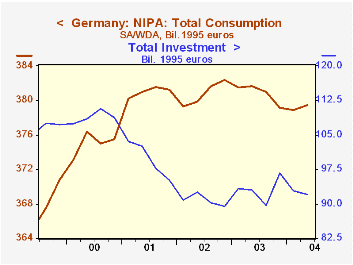 Global| Aug 24 2004
Global| Aug 24 2004Are Welfare and Labor Reforms Affecting Domestic Demand in Germany?
Summary
The final report on Germany's second quarter GDP, confirmed the preliminary estimate of a 0.5% increase from the first to the second quarter. The chief source of growth came from exports, which increased 3.19% from the first to the [...]

The final report on Germany's second quarter GDP, confirmed the preliminary estimate of a 0.5% increase from the first to the second quarter. The chief source of growth came from exports, which increased 3.19% from the first to the second quarter and 12.16% from the second quarter of 2003. Imports rose less than exports, and net exports rose 2.65%. Domestic demand remained sluggish. Consumer demand was essentially flat and total business investment declined by about 1% in the second quarter from the first.
Forward looking indicators, like new orders and business sentiment, suggest that activity in the third quarter is likely to continue muted. While the volume of seasonally adjusted new orders showed an increase for the second quarter, the June figure, published today, was down 3.44% from May. The most recent IFO index of expectations of the business climate in the next six months was up slightly in July, but the optimists among the institutional investors and analysts poled in the Zew indicator were fewer in August.
Part of the sluggishness in domestic demand in Germany may be the result of uncertainty engendered by the sweeping labor and welfare reforms posed by Agenda 2010 and the Hartz IV Laws, which were introduced in 2002, and the Rurup Commission appointed earlier this year to devise a plan to save the pension system threatened with collapse by the aging of the population.
In September, 2002, the Bundestag passed laws reducing monthly premium payments for the national health care system and reduced to 12 months the maximum duration a person can receive unemployment benefits after losing a job and made it easier for companies to hire and fire employees. The most contentious reforms--the Hartz IV Law--calling for the merger of unemployment and welfare benefits and provisions of the Rurup Commission to raise the age of retirement from 65 to 67 years of age and reduce pension levels from 48% to 40.1% of a recipient's former income have yet to be passed. Popular discontent over the reforms is rising, particularly in East Germany where unemployment rates and the numbers of long term unemployed remain high. August 23rd marked the fifth Monday of large scale demonstrations in East Germany against the reforms.
While the long term implications of the reforms are positive for the growth of the German economy, the implementation of the reforms in the short term are likely to be disruptive.
| Germany | ||||||||
|---|---|---|---|---|---|---|---|---|
| Gross Domestic Product (Bil. euros) | Q2 04 | Q1 04 | Q2 03 | Q/Q % | Y/Y % | 2003 % | 2002 % | 2001 % |
| Total GDP | 502.96 | 500.58 | 495.58 | 0.48 | 1.49 | -0.14 | 0.12 | 0.99 |
| Total Consumption | 379.43 | 378.51 | 381.68 | 0.14 | -0.59 | 0.00 | --0.05 | 1.60 |
| Total Investment | 92.03 | 92.80 | 92.91 | -0.85 | -0.95 | 2.49 | -8.93 | -8.39 |
| Net Exports | 31.50 | 28.85 | 20.99 | 2.65 | 10.51 | -11.84 | 38.71 | 31.90 |
| Exports | 202.60 | 196.34 | 180.64 | 3.19 | 12.16 | 1.75 | 4.10 | 6.12 |
| Imports | 171.10 | 167.45 | 159.65 | 2.16 | 7.17 | 3.94 | -1.57 | 1.35 |
| Unemployment Rates | Jul 04 | Jun 04 | Jul 03 | M/M | Y/Y | 2003 % | 2002 % | 2001 % |
| West Germany | 8.5 | 8.4 | 8.4 | 1.0 | 1.0 | 8.4 | 7.7 | 7.2 |
| East Germany | 18.5 | 18.5 | 18.6 | 0.0 | -1.0 | 18.5 | 17.7 | 17.3 |





